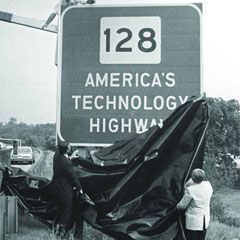The computer
industry in the United States largely developed in two main geographic areas.
The first in the North East, located along Route 128 and the second is Silicon Valley
in California. Geographical advantages and a new attitude to industrial organisation were significant in the success of the computer industry in America, especially
that of Silicon Valley compare to Route 128.
 |
| Route 128 in Massachssetts |
There were several
key advantages to the geographical set up of Silicon Valley that aided the development
of the computer industry in America. One key advantage of location was the network
created between educational institutions and industry. Famous universities such
as Stanford or Berkeley provided the sector with skilled engineers. They also created
programs cooperating with industry, Stanford’s Honors Cooperative Program for
example, and made research facilities available to industry. Additionally, lesser
known state colleges or community colleges also provided labour to the computer
Industry. The development of specialist services tied to the computer industry
in the region such as lawyer firms, PR firms, market research firms, consulting
companies were also important for the development of the industry.
 |
| Silicon Valley in California |
However one has to
bear in mind that in addition to location, industrial organization and management
played a significant role in the success of Silicon Valley. If one compares
Route 128 and Silicon Valley, they both had geographical advantages but Silicon
Valley had a more successful fate than Route 128. The attitude
and management organization that was used in Silicon Valley, which was in stark
contrast to the previous business organization of firms in Massachusetts. The development
of a competitive but cooperative attitude between firms and employees was key
to the spread of ideas in the computer industry. Employees from different firms
would often have lunches, help each other out if they had problems, even exchange
materials or equipment if they ran out. Moreover, firms such as Intel or HP
tried to minimize levels of hierarchy and executives were encouraged to interact
with all employees. This development of informal relations between and within firms
helped Silicon Valley adapt to the fast changing world of the IT and semi-conductor
industries.
 |
| Co-operation |
Geography could
also have reinforced some of the business or industrial organization that were present
in Silicon Valley. An example of this is the fact that all firms are in the same
location eases the mobility of employees and executives across firms. One of the key advantages of Silicon Valley was that people could move
to and from firms extremely easily. Since people could change firms without
having to relocate, without having to change their children’s schools, this made
this mobility far easier. Moreover, as people who worked in the industry all lived
in the same area, attended the same restaurants, went to the same conferences,
this reinforces the informal network which seemed to play such an important
role in the development and success of Silicon Valley. Therefore it seems location
may also have promoted the industrial organization that developed in the area.
 |
| Employee mobility |
Thus location was important
in the success of the computer industry in America with the development of networks
within these specialized regions. The development of different social
structures and industrial practices can help explain the diverging fates of
Silicon Valley and Route 128. However geographic clusters can also bring
certain disadvantages (high housing costs, congestion, etc.) which may hinder
the future of a so far very successful industry in Silicon Valley.




Comments
Post a Comment